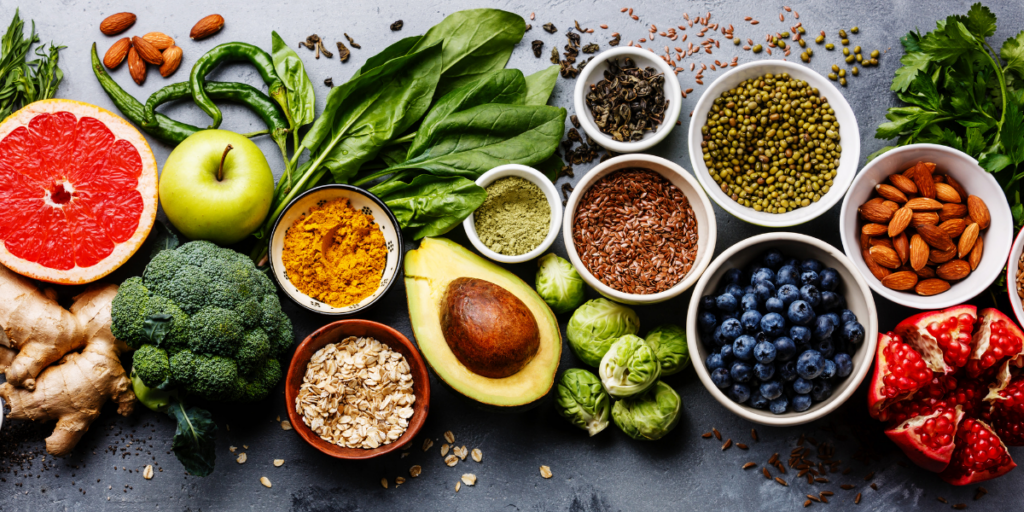No products in the cart.
The Truth About Superfoods

Superfoods are nutrient-dense foods that are beneficial for health and overall well-being. Super food’s main characteristic is its nutrient-density, which refers to the ratio of micronutrients (i.e.: vitamin, minerals, antioxidants, and phytocalories) per calorie.1 Micronutrients play major roles in preventing disease, fighting infection, energy levels, and overall health. The more micronutrients in each calorie of food has, the higher and better the nutrient-density of that food. Superfoods can be considered the top nutrient-dense foods.
Superfoods include fruits, vegetables, grains, legumes, and consistent of one ingredient; superfoods do not include processed or fried food. A superfood is simply a food that provides health benefits, rather than health risk. For example, citrus fruits contain vitamin C, which is associated with cancer prevention- so an orange can be considered superfood. On the other hand, potato chips contain saturated fat, which is associated with increased risk for developing heart disease- so this is not a superfood. The benefits of a potato, such as fiber, are outweighed by the disadvantages.
So, let’s take a step back and look at the big picture… If “superfoods” are simply whole foods that are made from the ground (not humans) that are high in vitamins and minerals, then why can’t we just call them whole foods or nutrient-dense foods? The truth is, you can call them just that because that’s all a super food it. “Superfoods” may simply be a marketing term for foods that have health benefits. The word superfood is the same as nutrient-dense, nutritious, healthful nutrient foods- there is no real difference between these terms!
These foods can actually include any vegetables, fruits, whole grains, seafood, eggs, beans and peas, unsalted nuts and seeds, fat-free and low-fat dairy products, and lean meats and poultry- all with little or no saturated fat, sodium, and added sugars.2 To identify specific “superfoods” within the above list, we must look for the foods highest in nutrients and lowest in calories.
This graphic above is the known as the ANDI Food Scores, developed by Dr. Fuhrman, rates the nutrient-density of foods.6 The green column represents our “superfoods.” These foods have the highest nutrient-per-calorie density, thus have the most health-promoting capabilities due to their high concentration of nutrients. Also, did you notice that the foods in the green column are the most colorful? This column includes dark green, orange-yellow, bright red to bluish-purple foods. While, as you move to the yellow (middle) and orange (right) columns, you can notice the food’s colors become blander. These columns still include whole fruits and vegetables, but their colors are lighter and paler colors.
When a food is very dark and bright with color (naturally), this is a sign it is nutrient-dense. By utilizing this reference point, you can select high in nutrient foods without having this chart on hand. The food color wheel illustrates how certain colors encompass various nutrients and what foods they are found in.5
Here is my color-coordinated description breakdown of nutrients, foods, and their health benefits:
Red
- Tomatoes contain lycopene, a phytochemical that may reduce prostate cancer risk.
Orange-Yellow
- Yellow, orange fruits (cantaloupe, carrots, apricots, sweet potato) contain carotene and vitamin A, which promote healthy skin and vision.
- Citrus fruits contain vitamin C, which acts as an anti-oxidant to prevent cancer and aids in wound healing.
Green
- Cruciferous vegetables contain sulfur, which detox carcinogens.
- Dark, leafy greens (spinach, kale, broccoli) contain vitamin K, which aids healthy blood clotting.
Purple
- Grape juice and red wine have resveratrol, which reduce platelet aggregation.
White
- Fermented dairy products have probiotics, which support GI health.
- Soy foods have isoflavones, which lower elevated cholesterol levels.
Brown
- Whole grains, such as flax seeds, wheat bran, oats, and barley, contain lignans, an anti-cancer and phytoestrogen.
Maybe it’s not specifically “superfood” you need, maybe its just a colorful piece of food! By choosing foods rich in color, you are choosing remarkably beneficial foods that are rich in vitamins, minerals, antioxidants, and phytochemicals. These delicious and energizing foods have the ability to lower cholesterol, reduce risk of heart disease and cancer, promote better moods, and more.
Instead of reaching for that bag of potato chips, reach for a food that is super- any fresh and unprocessed whole food! Grab a fresh fruit, vegetable, whole grain, lean protein, or low-fat dairy to unleash the powers of these foods. These foods are the difference between getting calories and getting nutrients; these food help heal, rather than hurt. As they say, “an apple a day keeps the doctor away!”
References
Morris, Julie. “Superfood Smoothies.” Sterling Publishing. New York. 2013.
ChooseMyPlate. “Nutrient (Nutrient Densitry).” Web Accessed 5 April 2017. <https://www.choosemyplate.gov/nutrition-nutrient-density>
http://www.webmd.com/diet/features/superfoods-everyone-needs#1
http://www.womansday.com/food-recipes/food-drinks/tips/g2211/best-superfoods/?slide=1&thumbnails=
http://4.bp.blogspot.com/-a5NfPMD7dqw/UeMHPdrasII/AAAAAAAABEw/FdSR5STH2hQ/s1600/colors.jpg
https://www.drfuhrman.com/learn/library/articles/95/andi-food-scores-rating-the-nutrient-density-of-foods
ChooseMyPlate. “Nutrient (Nutrient Densitry).” Web Accessed 5 April 2017. <https://www.choosemyplate.gov/nutrition-nutrient-density>
http://www.webmd.com/diet/features/superfoods-everyone-needs#1
http://www.womansday.com/food-recipes/food-drinks/tips/g2211/best-superfoods/?slide=1&thumbnails=
http://4.bp.blogspot.com/-a5NfPMD7dqw/UeMHPdrasII/AAAAAAAABEw/FdSR5STH2hQ/s1600/colors.jpg
https://www.drfuhrman.com/learn/library/articles/95/andi-food-scores-rating-the-nutrient-density-of-foods
